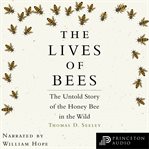Review by Booklist Review
Flying out on flower patrol, a honeybee discovers a whole prairie in bloom. After tasting the flowers' nectar, it races home and begins the waggle dance for the other bees, indicating the direction and distance of the flowers. The bees fly out to the prairie, collect nectar and pollen until sunset, and carry it back home. Chrustowski addresses the first bees directly in precisely worded sentences such as, Sip sugary nectar with your bendy-straw tongue. Yum! The second-person voice helps children imagine the bee's point of view. Further explaining the communication dances of honeybees is an appended note, a useful feature for adults fielding questions about how the process works. Most kids, though, will pick up the fundamentals from the main text and enjoy the fun of making their own bee dances. In the end, that physical engagement will make basic information stick. Simple but information packed, the text reads aloud well. The handsome, large-scale illustrations cut-paper collages highlighted with drawn elements make this book a terrific classroom read-aloud choice for units on bees or prairies.--Phelan, Carolyn Copyright 2015 Booklist
From Booklist, Copyright (c) American Library Association. Used with permission.
Review by Library Journal Review
PreS-Gr 1-This early science picture book focuses on honeybees' fascinating ability to communicate with one another about the whereabouts of food sources. Through minimal language and large, colorful spreads, a bee is depicted finding a prairie full of flowers, returning to the hive, and performing a dance that will indicate the distance and location of pollen to the other worker bees. A concluding page provides more in-depth information about the dance and about the beehives. Rendered in collage with pastel pencil illustrations in tones of mustard, brown, and green, the illustrations portray the interior of a hive and of the stores within, as well as the fields of flowers outside. While attractive, the images do not always clarify the wording. On one spread, the subjects are described as having a "bendy-straw tongue," but the accompanying illustration shows only a bee perched on a flower, with no protruding tongue. VERDICT A good nonfiction read-aloud option; suitable for science and nature units.-Eva Elisabeth VonAncken, formerly at Trinity-Pawling School, Pawling, NY © Copyright 2015. Library Journals LLC, a wholly owned subsidiary of Media Source, Inc. No redistribution permitted.
(c) Copyright Library Journals LLC, a wholly owned subsidiary of Media Source, Inc. No redistribution permitted.
Review by School Library Journal Review
PreS-Gr 1-This early science picture book focuses on honeybees' fascinating ability to communicate with one another about the whereabouts of food sources. Through minimal language and large, colorful spreads, a bee is depicted finding a prairie full of flowers, returning to the hive, and performing a dance that will indicate the distance and location of pollen to the other worker bees. A concluding page provides more in-depth information about the dance and about the beehives. Rendered in collage with pastel pencil illustrations in tones of mustard, brown, and green, the illustrations portray the interior of a hive and of the stores within, as well as the fields of flowers outside. While attractive, the images do not always clarify the wording. On one spread, the subjects are described as having a "bendy-straw tongue," but the accompanying illustration shows only a bee perched on a flower, with no protruding tongue. VERDICT A good nonfiction read-aloud option; suitable for science and nature units.-Eva Elisabeth VonAncken, formerly at Trinity-Pawling School, Pawling, NY (c) Copyright 2015. Library Journals LLC, a wholly owned subsidiary of Media Source, Inc. No redistribution permitted.
(c) Copyright Library Journals LLC, a wholly owned subsidiary of Media Source, Inc. No redistribution permitted.
Review by Horn Book Review
With simple text and cut-paper collages, Chrustowski traces one honeybee's journey from hive to meadow and back again, explaining how a scout bee uses a series of motions to communicate a harvest location. A brief afterword offers more information about the process, and the bright, broad illustrations offer enough detail for readers to identify every part of the bees. (c) Copyright 2015. The Horn Book, Inc., a wholly owned subsidiary of Media Source, Inc. No redistribution permitted.
(c) Copyright The Horn Book, Inc., a wholly owned subsidiary of Media Source, Inc. No redistribution permitted.
Review by Kirkus Book Review
A honeybee scout finds a nectar-rich prairie and returns to the hive to tell her sisters. Brilliant colors capture readers right away, the morning sky honey yellow and the grass and foliage bright green. The prairie is a riot of color and varietyblack-eyed Susans, purple coneflowers, bee balm, and more. The scout heads back to the hive for the titular dance, diagrammed against the comb. Chrustowski's simple language, appropriate for preschoolers and early-elementary children, captures the basics of the waggle dance in broad gestures: it describes a figure eight; its length indicates distance. Further detail is provided in an author's note. Cut-paper collage and colored pencils visually define bees, flowers, and hive boxes, both inside and out. The dance acts as the story's hinge; afterward a whole squadron of forager bees heads back to the prairie to gather nectar and pollen in another glut of color. The use of the second person invites children to identify first with the scout bee and then the foragers, a device that's reinforced by frequent close-ups. The tale is pleasingly bee-focused despite the depiction of a man-made hive; the emphasis is on bee communication and behavior, not beekeeping or protection, though respect for the insects is implicit. A tiny but remarkable one-day adventure that may well ignite entomological excitement in its readers. (Informational picture book. 3-7) Copyright Kirkus Reviews, used with permission.
Copyright (c) Kirkus Reviews, used with permission.

